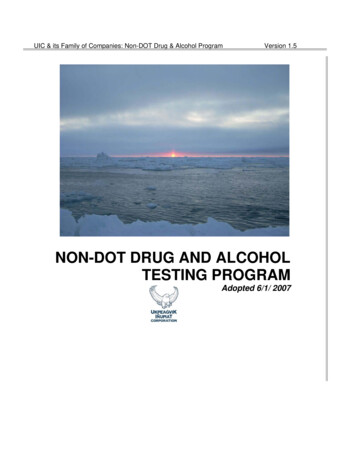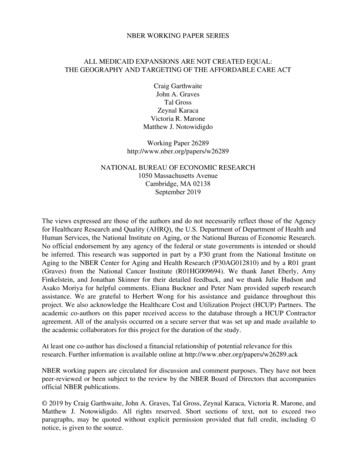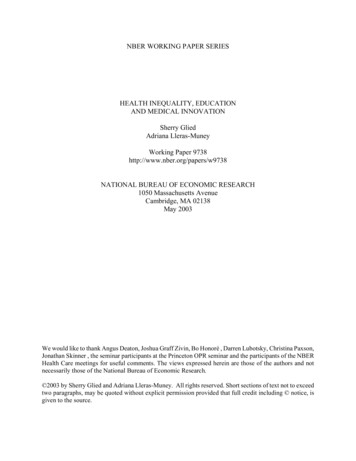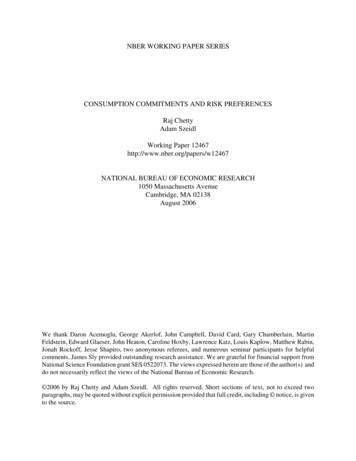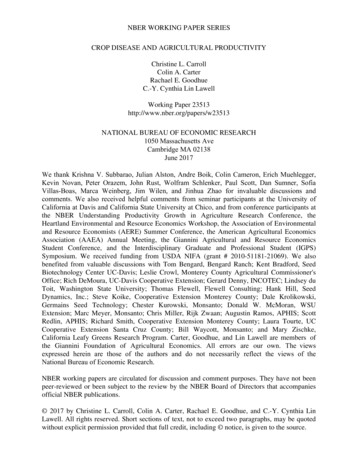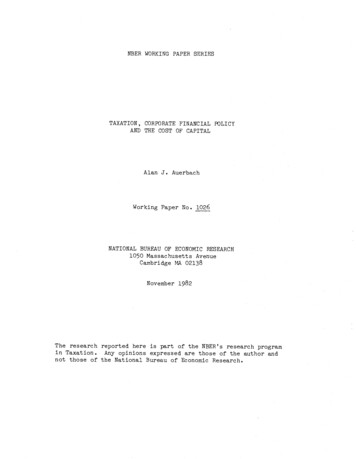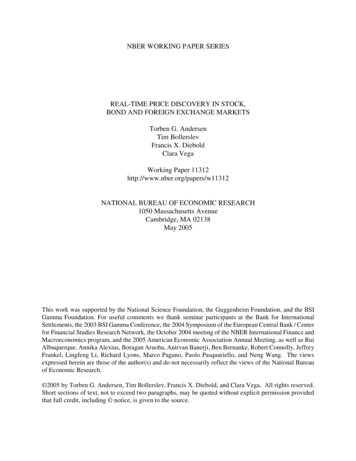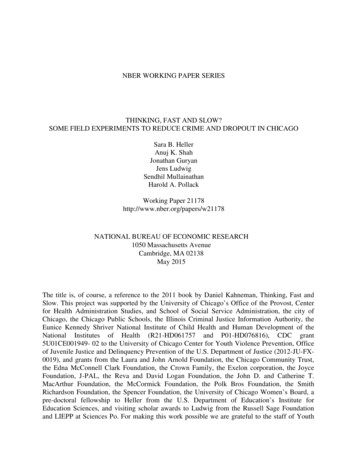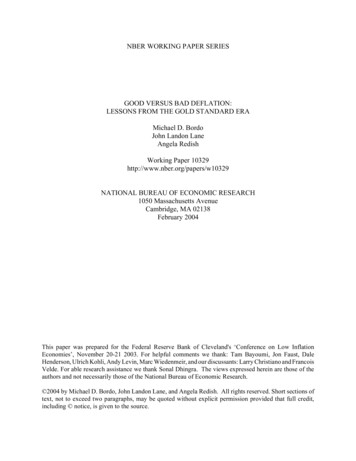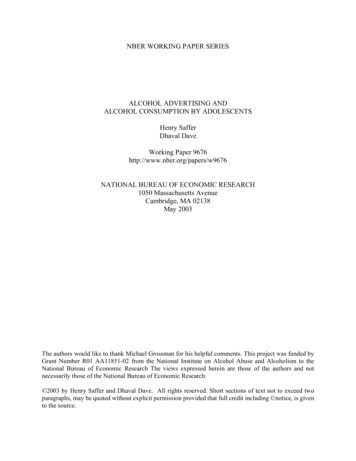
Transcription
NBER WORKING PAPER SERIESALCOHOL ADVERTISING ANDALCOHOL CONSUMPTION BY ADOLESCENTSHenry SafferDhaval DaveWorking Paper 9676http://www.nber.org/papers/w9676NATIONAL BUREAU OF ECONOMIC RESEARCH1050 Massachusetts AvenueCambridge, MA 02138May 2003The authors would like to thank Michael Grossman for his helpful comments. This project was funded byGrant Number R01 AA11851-02 from the National Institute on Alcohol Abuse and Alcoholism to theNational Bureau of Economic Research The views expressed herein are those of the authors and notnecessarily those of the National Bureau of Economic Research. 2003 by Henry Saffer and Dhaval Dave. All rights reserved. Short sections of text not to exceed twoparagraphs, may be quoted without explicit permission provided that full credit including notice, is givento the source.
Alcohol Advertising and Alcohol Consumption by AdolescentsHenry Saffer and Dhaval DaveNBER Working Paper No. 9676May 2003JEL No. I1ABSTRACTThe purpose of this paper is to empirically estimate the effects of alcohol advertising on adolescentalcohol consumption. The theory of brand capital is used to explain the effects of advertising onconsumption. The industry response function and the evidence from prior studies indicate that theempirical strategy should maximize the variance in the advertising data. The approach in this paperto maximizing the variance in advertising data is to employ cross sectional data. The Monitoringthe Future (MTF) and the National Longitudinal Survey of Youth 1997 (NLSY97) data sets, whichinclude only data for adolescents, are employed for the empirical work. These data sets areaugmented with alcohol advertising data, originating on the market level, for five media. Use ofboth the MTF and the NLSY97 data sets improves the empirical analysis since each data set has itsown unique advantages. The large size of the MTF makes it possible to estimate regressions withrace and gender specific subsamples. The panel nature of the NLSY97 makes it possible to estimateindividual fixed effects models. In addition, very similar models can be estimated with both datasets. Since the data sets are independent, the basically consistent findings increase the confidencein all the results. The results indicate that blacks participate in alcohol less than whites and theirparticipation cannot be explained with the included variables as well as it can for whites. Acomparison of male and female regressions shows that price and advertising effects are generallylarger for females. Models which control for individual heterogeneity result in larger advertisingeffects implying that the MTF results may understate the effect of alcohol advertising. The resultsbased on the NLSY97 suggest that a compete ban on all alcohol advertising could reduce adolescentmonthly alcohol participation by about 24 percent and binge participation by about 42 percent. Thepast month price-participation elasticity was estimated at about -0.28 and the price-bingeparticipation elasticity was estimated at about -0.51. Both advertising and price policies are shownto have the potential to substantially reduce adolescent alcohol consumption.Henry SafferNational Bureau of Economic Research365 Fifth Avenue 5th floorNew York NY 10016-4309hsaffer@gc.cuny.eduDhaval DaveNational Bureau of Economic Research365 Fifth Avenue 5th floorNew York NY 10016-4309ddave@gc.cuny.edu
1. IntroductionPublic health advocates have expressed concern that alcohol advertising is a factorcontributing to adolescent alcohol consumption. Both the level of alcohol consumption byadolescents and the level of alcohol advertising are considerable. Data from the 2001 Monitoringthe Future Surveys (MTF) show that 7.7 percent of 8th graders, 21.9 percent of 10th graders and 49.8percent of 12th graders consumed alcohol within the past 30 days (Johnston, O’Malley, Bachman,2002). A Federal Trade Commission (FTC) report (1999) documents several outcomes associatedwith underage drinking. These include reduced educational attainment, increased fatal motorvehicle crashes, increased suicide attempts and increases in sexually transmitted diseases. Theprobability of alcohol problems in adulthood also increases as the age of alcohol onset decreases.Competitive Media Reporting (CMR) estimated that alcohol producers spent about 1.5 billion onmeasured media advertising in 2001. This was a 25 percent increase over spending in 1998.Alcohol industry reports to the FTC suggest that measured media advertising account for only onehalf to one third of total promotional expenditures. Other forms of alcohol promotion include:sponsorships; internet advertising; point-of-purchase advertising; consumer novelties; productplacements in movies and TV shows; direct mail; price promotions; and trade promotions directedat wholesalers and retailers. These expenditures may enhance the effectiveness of measured mediaspending.Although there is a considerable level of alcohol advertising, the alcohol industry arguesthat its advertising codes prohibit content and placement of advertising which target underageindividuals. The advertising codes require that more than 50 percent of the exposed audience beover 21. The advertising codes also prohibit use of actors who appear underage and prohibit the use
of Santa Claus. Cartoon characters, however, are not restricted and beer advertisers have norestrictions on the use of sports celebrities.1The Center on Alcohol Marketing and Youth (2002) examined the exposure of youth toalcohol advertising in magazines, on TV and on radio. Youth are defined as individuals under theage of 21. They found that in 2001, advertisers delivered 45 percent more beer advertising to youththan to adults in magazines. For spirits, 27 percent more magazine advertising was delivered toyouth than to adults. However, for wine youths saw 58 percent less advertising than adults. Youngadults, defined as ages 21 to 34, were exposed to slightly more magazine alcohol advertising thanthose under 21. Adults over 34 were exposed to the least amount of alcohol advertising inmagazines. They also found that on TV underage youth were exposed to two beer or ale ads forevery three seen by an adult. Beer and ale ads on TV represent about half of all alcohol advertisingin all media. On radio, youth heard 8 percent more beer and ale advertising, 12 percent moremalternative advertising and 14 percent more advertising for distilled spirits than adults 21 andolder. Youth heard substantially less radio advertising for wine. Grube (1995) reviews research onthe effect of alcohol advertising on knowledge, attitudes and intentions to drink by adolescents. Hefinds that much of the imagery in alcohol advertising does appeal to youth and that this advertisingincreases positive expectations about alcohol.Studies of advertising exposure has led some public health groups to conclude that there is alink between advertising and adolescent alcohol consumption. The Robert Wood JohnsonFoundation (1999) concludes that alcohol advertising and marketing are factors in the environmentthat help create problems of underage drinking. There is, however, very little empirical evidencethat alcohol advertising has any effect on actual alcohol consumption (see for example, Nelson,1The beer, wine and spirits industries each have a somewhat different advertising code.2
1999 or Fisher, 1993). Although both the level of alcohol consumption among adolescents and thelevel of alcohol advertising are substantial and well documented, the link between the two remainsa controversial subject. There are no econometric studies of the effect of alcohol advertising onadolescent drinking. The purpose of this paper is to provide these empirical estimates. The empiricalmodels include gender and race specific regressions of the effect of alcohol advertising.2. Theoretical FrameworkCompetition through advertising, rather than price, is often preferred in industries that arehighly concentrated, such as the alcohol industry.2 Schmalensee (1972) shows that oligopoly firmsare likely to advertise more than similar firms in monopoly situations. Oligopoly firms attempt toincrease their share of the market with advertising rather than with price competition. Each firmwill be reluctant to use price competition if they believe that their rivals will also cut price. If allfirms cut price, they all move down an inelastic demand function similar to the industry demandfunction. Share of market will not increase and revenue will decline. Advertising research usuallyfinds that the firm with the largest share of voice has the largest share of market.3 Each firmattempts to advertise more than their rivals, which results in a high level of industry advertising.The advertising-to-sales ratio for the alcohol industry is about nine percent, while the average for allindustries is about three percent (Advertising Age, 1999).Becker and Murphy (1993) argue that advertising can be viewed as a complement to theadvertised good. They define the complementary good as a favorable image about the advertisedgood. This increases the marginal utility of consumption and thus increases demand. Becker andMurphy’s concept can be expanded somewhat and placed in the context of advertising theory.Since advertising has a cumulative effect, the complementary good can be described as a stock and2This is less true for wine than for beer and spirits.3
in advertising theory is called brand capital. Brand capital is defined as the collective positiveassociations that individuals have about a brand. Advertising is one method of adding to or alteringbrand capital. Brand capital depreciates over time and at differential rates for different brands. Asbrand capital depreciates, a firm can attempt to offset the resulting decreases in sales with thecreation of additional brand capital. Depending on the relative marginal costs and marginalbenefits, the additions to brand capital can come in the form of new brands or from changes in thecontent and level of advertising for existing brands. If advertising were banned, there would onlybe limited possibilities to offset brand capital depreciation. This would reduce the marginal utilityof consumption and reduce sales.Empirical studies of alcohol advertising estimate an alcohol demand equation. The alcoholdemand function is derived by assuming that a consumer maximizes a utility function, whichincludes alcohol as one of its arguments, subject to a budget constraint. The complementarity ofbrand capital suggests that alcohol advertising will increase the marginal utility of alcohol and thusincrease demand. This optimization problem results in an equation which shows that the demandfor alcohol is a function of alcohol price, alcohol advertising, and other variables affecting alcoholdemand such as income, availability of alcohol, alcohol sentiment and other taste variables.Aggregating across consumers results in the market demand function.Economic theory predicts that the relationship between advertising and consumption issubject to diminishing marginal product. This concept is the basis of the advertising responsefunction. Advertising response functions have been used in brand level research to illustrate theeffect of advertising on consumption at various levels of advertising. Economic theory suggeststhat due to diminishing marginal product, advertising response functions flatten out at some point.3Share of voice is the firm’s advertising as a percent of total industry advertising.4
That is, after a certain point consumption becomes ever less responsive to increases in advertising.Ultimately consumption is completely unresponsive to additional advertising. Brand levelempirical work on beer advertising clearly supports this diminishing marginal product assumption(Rao and Miller, 1975; Ackoff and Emshoff, 1975). One important implication of diminishingmarginal product is that, since media are not perfect substitutes, media diversification is necessaryto maximize the effect of a given advertising budget. This point can also be made with respect toother forms of promotion.The same theory which describes the brand level advertising response function can beapplied to the product level. The product level is defined as all products produced in the industry.For example, the product level for alcohol would include all brands and variations of beer, wine andspirits. The product level advertising response function is similar to the brand level function and isgraphed in figure 1. The vertical axis measures product level consumption and the horizontal axismeasures product level advertising. The product level response function is different from the brandlevel response function in that advertising-induced sales must come at the expense of sales ofproducts from other industries. Increases in consumption come from new consumers or fromincreases by existing consumers. New consumers are often adolescents who are uninformed aboutthe true costs and benefits of alcohol consumption.The two response functions represented in figure 1 and in figure 2 help to illustrate thelikely outcome of alternative methods of measuring advertising. There are three methods ofmeasuring advertising used in econometric studies of advertising and total consumption. Thesethree categories are: 1) studies which use annual or quarterly national aggregate expenditures as themeasure of advertising, 2) studies which use cross sectional measures of advertising and 3) studies5
of advertising bans. Table 1 provides a brief summary of the data and results from prior empiricalstudies of alcohol advertising.The most common type of study uses a time series of national expenditures as the measureof advertising. National advertising expenditures are the total of all alcohol advertisingexpenditures, for all advertisers, in all media, for all geographic market areas. This is a high levelof aggregation of the advertising data and as a result the data have very little variation. Sincealcohol is heavily advertised, the marginal product of advertising may be very low or zero. Infigure 1, this is equivalent to measuring advertising in a small range around Al. The loss ofvariance due to national aggregation leaves little to correlate with consumption and since theadvertising occurs at a level where the marginal effect is small, it is not likely that any effect ofadvertising will be found. As table 1 indicates, very little effect of advertising is found by suchstudies.A far less common type of study uses cross sectional data to measure alcohol advertising.This type of study is less common since the data are more difficult to acquire. Cross sectional datacan differ but would typically be local level, such as a Metropolitan Statistical Area and has greatervariation than national level data for several reasons. One reason for variation in advertising levelsis that the cost of advertising varies across local areas. This is illustrated in figure 2 by the threedata points Am1, Am2 and Am3. An econometric study which uses local level data would havepotentially larger variation in advertising levels and in consumption. When the data are measuredover a relatively larger range, there is a greater probability of being in an upward sloping portion ofthe response function. Local level advertising data are thus more likely to find a positiverelationship between advertising and consumption. As table 1 indicates this type of study finds apositive effect of advertising.6
The third category of studies is based on alcohol advertising bans. The potential effect of aban on certain media is shown as a downward shift of the response function in figure 1. Anadvertising ban may not reduce the total level of advertising but will reduce the effectiveness of theremaining non-banned media. The reason for this is as follows. A ban on one or more media willresult in substitution into the remaining media. However, each media is subject to diminishingmarginal product. The increased use of the non-banned media will result in a lower averageproduct for these media. This shifts the response function downward. Firms may or may notrespond to this decrease in effectiveness of their advertising expenditures. Firms may try tocompensate with more advertising which would be illustrated by moving to a higher level ofadvertising on a lower advertising response function.4 Firms might increase the use of othermarketing techniques such as promotional allowances to retailers. As indicated in table 2 this typeof study has found that advertising bans do reduce alcohol consumption.3. DataThe first data set employed in this study is the Monitoring the Future surveys (MTF). TheMTF data used in this study are a pool of the 1996 and 1998 cross sections of 8th graders, 10thgraders and 12th graders.5 This pool is a nationally representative sample of over 63,000 highschool students. The pooling of the 1996 and 1998 surveys provides sufficient samples for separateanalysis of the effects of alcohol advertising by race and gender. This is interesting since there maybe differential effects of advertising by race and gender. Pooling these two years also provides anadditional time variance in the alcohol advertising and price variables.4In a simple model, the decrease in marginal product would reduce the use of the input. However in an oligopolymodel, with response to rivals, one reaction to reduced sales is to increase advertising.5A special version of the MTF data which merged advertising and prices to individual records was made available tothis project. This special data set contained only a limited number of individual specific variables.7
The MTF surveys provide data on drinking occasions in the past year as well as the pastmonth and the number of times in the past two weeks that the respondent had five or more drinks inone occasion. Three dichotomous alcohol participation variables were constructed from these data.These are past year participation, past month participation and binge participation. The bingedrinking variable is defined as one if the youth had at least one drinking occasion in the two weeksprior to the survey in which five or more drinks were consumed, and is zero otherwise. Bingedrinking represents those occasions most likely to have negative consequences and to be of concernto policy makers (i.e., drinking five or more drinks in a single occasion and then driving is expectedto significantly raise the probability of a motor vehicle accident and, potentially, death).Several independent variables were constructed from the socioeconomic and demographicquestions included in the surveys. These variables are: the individual’s income, gender, age andrace (white, black, Hispanic or other)6. The regressions also include a single time dummy. Table 2provides summary definitions and means for the variables which were used in the regressions withthe MTF data.The second data set employed in this study is the National Longitudinal Survey of Youth1997 (NLSY97). The sample consists of approximately 10,000 youths who live in the US and whowere 12 to 16 years old as of December 31, 1996. Using a statistically selected representativesample of all households, based on the 1990 Census, the sample is representative of adolescentsnationwide. The NLSY97 data provide an important alternative to the MTF by includingindividuals who are not in school and by including data collected from the parents. It is also a paneldata set, which allows for estimation of individual fixed effects models. The NLSY97 data set usedfor the regressions was constructed from the 1997 and 1998 panels.8
The NLSY97 surveys provide data on alcohol consumption and basic demographics. Thealcohol variables include past month alcohol participation and binge participation. Bingeparticipation is defined as one if the youth had at least one drinking occasion during the 30 daysprior to the survey in which five or more drinks were consumed, and is zero otherwise. Theindependent variables constructed from the demographic questions include the individual's income,gender, age and race (black, Hispanic or other).In addition, the NLSY97 provides data on a number of other factors which may influencealcohol consumption. The NLSY97 includes a set of questions on schooling, academicachievement and aptitudes. These include a dichotomous variable equal to one for youths currentlynot in school. A variable measuring years of schooling completed was also defined. Also, avariable measuring the individual's math score on the Peabody Individual Achievement Test wasdefined. In addition, a set of variables which measure parental supervision were defined. Theseinclude a variable which measures how often the respondent eats dinner with their family. Areview by the Council of Economic Advisors (2000) found this variable to be a significant predictorof alcohol use. Also, the respondents are asked to report the number of times during a typical weekthat they do something religious as a family. The response data ranges from zero to seven.Furthermore, a youth's ability to cope with stress and the difficulties of adolescence may affect theiralcohol consumption. Youths that report that they can get emotional support from their parentsmay be less likely to use alcohol. An index of family relationship is provided in the NLSY97. Thisindex takes on values from zero to 32, with higher values indicating a closer relationship. Inaddition, a household size variable is defined. Also a dichotomous variable equal to one if theindividual worked in the past year was defined. A dichotomous variable measuring the presence of6The other category includes individuals who did not respond to the race question to minimize loss of data due to non-9
another individual during the interview was also included. Finally, a year dummy is included.Table 3 provides summary definitions and means for the variables which were used in theregressions from the NLSY97.Advertising data, alcohol price data and cost of living data are appended to both the MTFand the NLSY97. Since 1996 and 1998 MTF data and 1997 and 1998 NLSY97 data are used in thisstudy, the advertising data which was purchased includes the years 1996 to 1998. The advertisingdata come from Competitive Media Reporting (CMR). CMR collects advertising data in broadcast,outdoor and other media. The reliability of these data is widely recognized in the advertisingindustry. All of the data reported by CMR are independent estimates and do not use anyinformation from alcohol producers. The data are collected by monitoring the media, frombroadcast station reports and advertising wholesalers’ reports. Only alcohol advertising data withlocal variation have been used in this study. Network television, syndicated television, cablenetwork television and network radio all have no local variation and in a regression model thesedata would simply affect the intercept. Spot television, spot radio, outdoor and newspapers all havelocal variation and are reported by advertising market areas. Magazine advertising can also beincluded since national advertising expenditures and local circulation are available. Localmagazine advertising is estimated by multiplying national advertising by the percent of totalcirculation in the local market. An advertising market area is known as a Designated Market Area(DMA) and is similar to a Metropolitan Statistical Area. The advertising data were appended to theindividual records by DMA. This approach provides cross sectional variance in the advertising data,which is an important empirical issue in measuring the effect of advertising. A single mediaresponse. Excluding observations with missing race information does not materially change the results.10
aggregated advertising variable is useful because it accounts for all media and media substitutionwhile avoiding problems of colinearity between media.The advertising variable which is appended to the individual data should approximate theexposure of an average youth to alcohol advertising. The local level alcohol advertising data thatare available include: spot television expenditures, spot radio expenditures, outdoor expenditures,magazine expenditures and newspaper expenditures. National level advertising has no localvariation and is not included. The construction of the advertising variable assumes a competitivemarket for advertising. Let:Atv a spot TV advertising message,Ai an advertising message in other local media, i,Ptv price of a TV advertising message,Pi price of an advertising message in other local media, i andPtv qiPi where qi measures the impact of a TV advertisement relative to an advertisement in anotherlocal media.The advertising variable is constructed by converting all expenditure data to TV equivalentmessages. This conversion can be done by assuming that the price of a TV message relative to theprice of a message in another media is equal to impact of the TV message relative to the impact of amessage in another media. The price of TV advertising is calculated using data on number of secondsand advertising expenditures on spot TV. The price per second is calculated from these data bydividing expenditures by number of seconds which was done, by year, for each DMA. TV equivalentmessages for media i are Ai/qi. If A measures total TV equivalent messages, then A Atv Σ Ai/qi.Since Atv can be multiplied by Ptv/Ptv, and 1/qi replaced by Pi/Ptv, then A AtvPtv/Ptv Σ AiPi/Ptv. TotalTV equivalent messages are thus equal to the sum of advertising expenditures on the five local media,11
divided by the price of one second of spot TV advertising. Since the number of messages in a DMAincreases with population size, the total message variable is divided by DMA population.7An important aspect of advertising is that its effects linger over time. That is, advertising inone period will have a lingering, although an ever smaller effect, in subsequent periods. This couldbe modeled as a Koyck transformation with constant rate of decay. A stock of advertising is createdsince in each period new advertising is added to the depreciated advertising from prior periods.However, the rate of decay from one period to the next is unknown and remains an arguable issue.Research such as Boyd and Seldon (1990) finds that specific advertisements fully depreciate withina year. An advertisement for a specific product helps create a personality for that product but it alsocreates an expectancy about alcohol in general. Even if a specific advertisement completely decaysin less than a year, the expectancy about alcohol may linger for a longer period. If the decay rateand structure were known, then a measure of stock could be calculated.The dependent variables which are used in this paper are annual participation, monthlyparticipation and binge participation. Annual advertising can be matched to annual participation,and annual advertising can be assumed to be a proxy for the stock of advertising when monthlyparticipation data are used.8 The regression results are interpreted as an estimate of the marginaleffect of an increase in annual advertising on annual, monthly alcohol participation and bingeparticipation.Since beer is the most widely used alcoholic beverage by underaged drinkers the price ofbeer is used in the demand functions. Data on the money price of beer was taken from the Inter-City7According to the Center on Alcohol Marketing and Youth, youth exposure is in the same range as overall populationexposure.8The stock of advertising is equal to the current period advertising plus the discounted value of advertising from priorperiods. Let advertising in each period be equal to an average value plus a positive or negative deviation from thisaverage value. The sum of the discounted values of the deviations can be assumed to equal zero. The stock of12
Cost of Living Index, published quarterly by the American Chamber of Commerce ResearchersAssociation (ACCRA). This data set includes prices for all the years and DMAs included in thedata sets. The ACCRA data contain the price of standard brands of beer for the years included in thealcohol data sets.The price of beer and income are adjusted for local cost of living and price changes over time.Data on the local cost of living were taken from the Inter-City Cost of Living Index, publishedquarterly by the American Chamber of Commerce Researchers Association (ACCRA). TheACCRA cost of living index is based on over sixty categories of consumer purchases and usesexpenditure weights based on government survey data of expenditures of mid-management households.The ACCRA cost of living index has no time variation and is indexed to one for the average cost ofliving. Price changes over time were measured with the national CPI for all urban consumers reportedin Business Conditions Digest (Bureau of Economic Analysis, USDC). The cost of living index used toadjust beer prices and income was computed by multiplying the ACCRA index by the national CPI.4. ResultsThe first empirical issue is potential endogeneity between alcohol advertising and youth alcoholparticipation. One source of endogeneity reflects the direction of causality. Current period advertisingcould be a function of aggregate sales in the prior period for the overall population. However, in themodels estimated in this study, the dependent variables are dichotomous indicators of youth alcoholparticipation, which may only be weakly correlated with consumption in the overall population.Furthermore, while reverse causality may run from past period sales to current period advertising, themodels in this study estimate current period consumption as a function of current or past periodadvertising. Thus, a priori, this source of endogeneity does not appear likely. Another form ofadvertising will equal the average value times a factor which will be greater than one. The
These expenditures may enhance the effectiveness of measured media spending. Although there is a considerable level of alcohol advertising, the alcohol industry argues . Beer and ale ads on TV represent about half of all alcohol advertising in all media. On radio, youth heard 8 percent more beer and ale advertising, 12 percent more .
